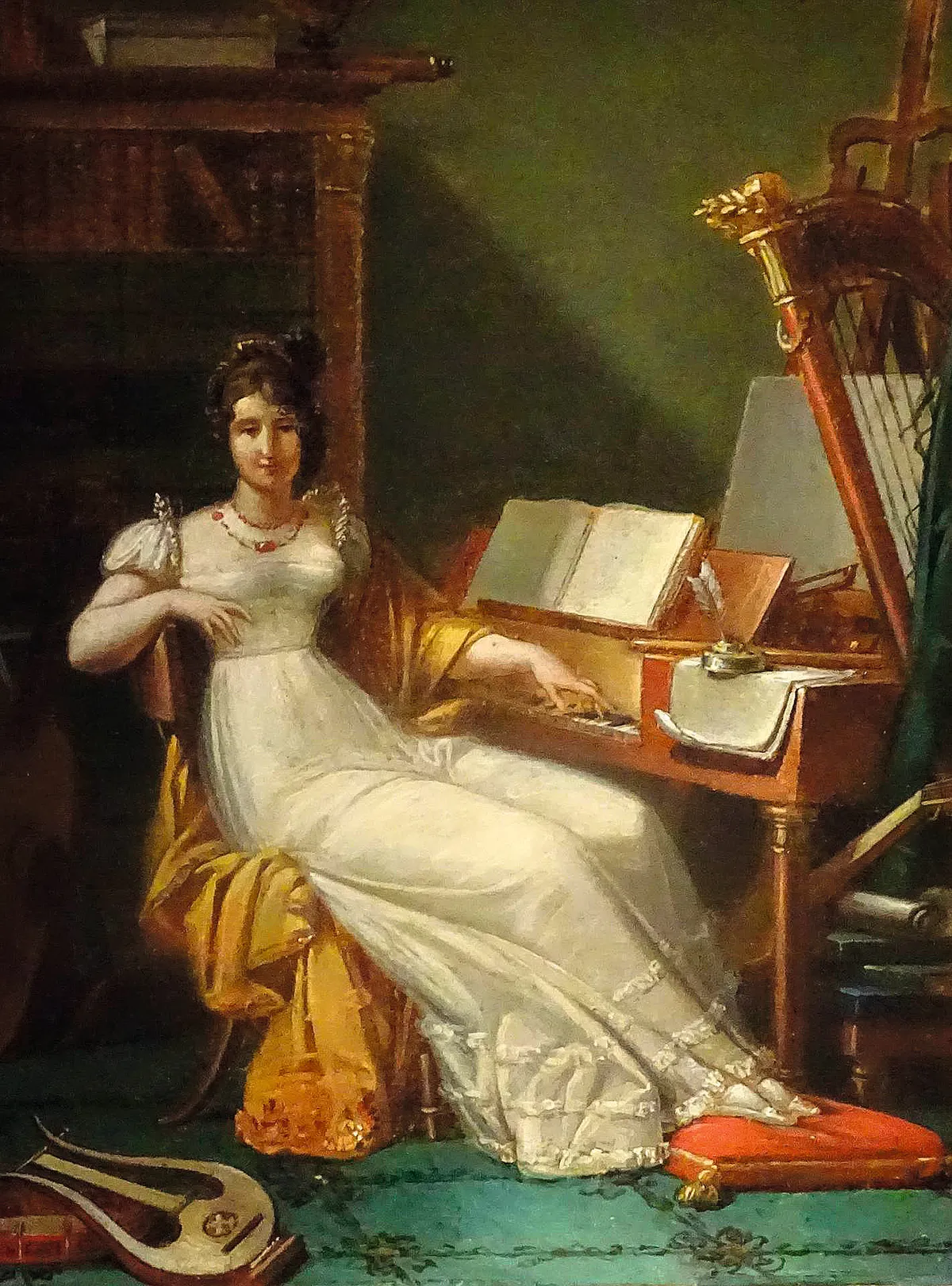The year is 1794. The Reign of Terror is in full swing in Revolutionary France, with thousands being executed at the guillotine. The latest imprisoned aristocrat, Hélène de Montgeroult, appears before the Committee of Public Safety who will decide her fate.
Hélène de Montgeroult is not alone. As well as the police guard, this 30-year-old woman is accompanied by an item more typically found in a Parisian salon than a courtroom – a piano. She is reputed to be one of the country’s finest musicians, and if she’s good, as the delegation of musicians advocating for her have promised, then she could be of use, first for ‘patriotic events’, later at the capital’s new conservatoire. She is invited to take her seat at the keyboard, to play for her very life.
Almost inevitably, she is asked to perform La Marseillaise, a 1792 rallying cry that would soon become the national anthem of the new French republic. What the pianist does with it is unexpected: after playing the tune, she begins to improvise variations on it, the music gradually building to a great climax, the melody billowing out over arpeggios. The men listening are moved to tears. She walks free.
Who was Hélène de Montgeroult?
Though incredible, this story appears to be far more truth than myth. Yet the woman who pulled off this miraculous save has been all but forgotten. Her name was Hélène de Montgeroult, born Hélène de Nervo into a noble family in Lyon, 1764. A prodigy pianist taught by the finest in Paris, she did indeed go on to work at the Paris Conservatoire, becoming its first female professor of music in 1795.
She also, remarkably, both composed at a time when it was rarely acceptable for a woman to do so and also had her work published. By her death, in Florence in 1836, she had written nine piano sonatas and, between 1788 and 1812, her magnum opus: 114 Etudes, which appeared in the hefty Cours complet pour l’enseignement du forte-piano of 1816 alongside a selection of fantasies, nocturnes for voice and piano and other short pieces. Yet her legacy has remained sidelined – until now.
‘I don’t know how often great historical composers are discovered, but this is really exciting,’ says pianist Clare Hammond, who has recorded 31 of Montgeroult’s Etudes for BIS (out this November). ‘Great composers have a unique voice. They use similar techniques to other composers but there’s something they do that makes it special. She has that.’
Hammond first heard about Montgeroult in 2019, thanks to French musicologist Jérôme Dorival. Since then, she has played several of the etudes as encores, leading the way in bringing Montgeroult to the UK. Dorival’s work underpins almost everything we now know about the French musician: his is the only biography (in French), he has been typesetting her scores and it was thanks to his scholarship that in 2006 her music was heard again.
'The missing link between Mozart and Chopin'
In the past few years, a handful of French and Francophone pianists have recorded discs of her music. In the summer of 2022, she featured as a BBC Radio 3 Composer of the Week. Finally, Montgeroult may be receiving her due.
Montgeroult breaks down our conceptions of the boundaries between the Classical and Romantic eras – Dorival describes her as the ‘missing link between Mozart and Chopin’. ‘The music is so prescient,’ says Hammond; ‘there is a Classical sensibility in the lightness of touch you need, which I think is broadly due to her writing for fortepiano. It took me a long time to find the right voice for her music because it seems, from the style, to be of a later era.’ Montgeroult’s harmonic language is more advanced, for starters, while her love of the singing tone at the piano, an idea popularised by Chopin’s bel canto melodies, is also ahead of its time.

The Etudes showcase Montgeroult’s originality and versatility. The first 20 or so are almost akin to extended exercises, but then, notes Hammond, rather like Carl Czerny’s School of Velocity they start to blossom: ‘There’s such stylistic variety.’ Each fulfils a practical function – to make fingers supple (No. 34), for instance, or to balance melody and accompaniment (No. 38) – yet becomes a piece of poetry, rather like Chopin achieved with his later Etudes.
A forgotten composer who anticipated Romanticism
‘For me, No. 111 in G minor encapsulates her style of Romanticism,’ says Hammond. ‘It’s not melodramatic – it has a more Enlightenment sensibility in Romantic clothes, with a more forward and modern harmonic language. No. 62 in E flat major is beautiful, flowing, calming with very subtle harmonic twists, while No. 38 in A minor is one of the simplest ones I’ve recorded. It’s very beautiful and heart-rending.’
Somehow, this forgotten composer anticipated the developments of the Romantic era. ‘Chopin’s C minor Etude sounds less “Revolutionary” after you’ve heard Montgeroult’s swirling Etude No. 107, which anticipates it by 20-odd years,’ wrote Erica Jeal in The Guardian.
Proof that the early Romantics knew her work is hard to come by, yet pianist Edna Stern noted in an interview about her Montgeroult recording that ‘from a musical point of view, it seems evident that Chopin, Mendelssohn and Schumann were very well acquainted with her work’. It’s clear that Montgeroult knew the pianist Marie Bigot, who taught Fanny and Felix Mendelssohn, and it’s thought that Friedrich Wieck, Clara Schumann’s father, may have known Montgeroult’s method.
A Bachian soundworld
When it came to the Romantic Bach revival, spearheaded by Felix Mendelssohn, again Montgeroult was a step ahead. She got hold of copies of Bach scores – her interest probably piqued by one of her teachers, Nicolas-Joseph Hüllmandel, himself thought to be taught by CPE Bach – and a Bachian influence threads throughout her music, in canons, fugues and polyphony. Montgeroult herself cites JS Bach, Handel and Scarlatti as her predecessors. Years ahead of Brahms or Reger, her Etude No. 106 melds Romanticism with a Bachian chorale.
One of the difficulties of rediscovering Montgeroult has been the slim historical paper trail. Only 24 copies of her Cours complets survive in libraries today; her only child did not preserve her letters or manuscripts. One important source comes from Montgeroult herself, who wrote extended introductions to the Cours complets.
‘I have a real sense that she completely understood the practicalities of what she was asking people to do,’ Hammond says. ‘She must have been a really formidable pianist. She focuses on creating a singing tone, which was quite a novelty at that time. And you can tell she was a very sensitive teacher from the way she phrases things.’
What else do we know about Hélène de Montgeroult?

'Hélène de Montgeroult must have been quite phenomenal, I think, intellectually and musically.’ She was also, says Hammond, resourceful. Before the Marseillaise incident, Montgeroult had already been through difficult times. Married to the Marquis de Montgeroult, she found herself in Great Britain in 1792 on a secret diplomatic mission on behalf of the French royal family.
The following year, they headed to Naples as diplomats, but the entire delegation was kidnapped en route by Austrian soldiers. Her husband was held in a dungeon, while Montgeroult was eventually set free from prison. Once out, she tried to help those still held captive.
Colourful stories, tantalising glimpses
‘She was good at working out who had influence and how to pull strings. We can see that from the letters she wrote when she was trying to get the others out of prison.’ Montgeroult had some success but not, alas, for her husband, who died before he could be released. She married twice more and gave birth to her son, father unknown.
We have these colourful stories and tantalising glimpses of Montgeroult, though she lacked a public profile to rival the celebrated Romantic composers and pianists who succeeded her.
Performing in public was out of bounds for the aristocracy, nor does she appear to have craved the limelight, but in her lifetime her talent was renowned among connoisseurs. Behind closed doors, her salon attracted the crème de la crème of society. One of her friends was the novelist Madame de Staël, who may have immortalised her in the 1807 novel Corinne.
More importantly, for this story at least, de Staël may have inspired Montgeroult to publish her work. It’s thanks to her music being in print that, after two centuries of silence, Montgeroult has a second chance.
Playing Montgeroult, by Clare Hammond
I started to play Montgeroult’s Etudes as encores in September 2020. At first people thought her music was nice but were sometimes dismissive. It was only when I had worked on the Etudes for a while that I started to discover the subtleties of her music, and now people are really engaging with it.

Other performers are doing her music, but not enough to create a school or standard way of doing it, so you don’t have that kind of body to draw on. With composers we know well, we take for granted how much of the legwork has already been done – we know what the context is, so the music immediately means more to us.
I recorded on a Steinway in Wyastone Hall in Monmouth. Because of Covid-19, I couldn’t try out the music as much as I’d want on historical instruments, but I did have a clavichord on a long-term loan. Montgeroult wouldn’t have been writing for that, but because you can do very slight crescendos on notes on the clavichord, it gave me the opportunity to try out the melodies and shape them in a way that really helped. The singing tone is so crucial to Montgeroult’s music.
